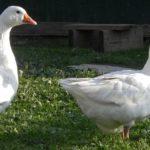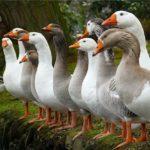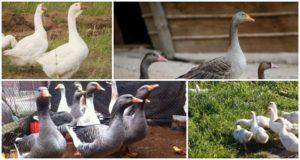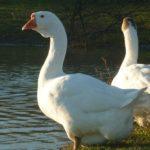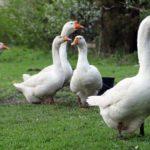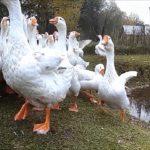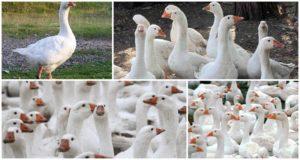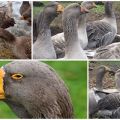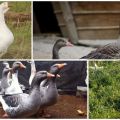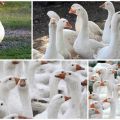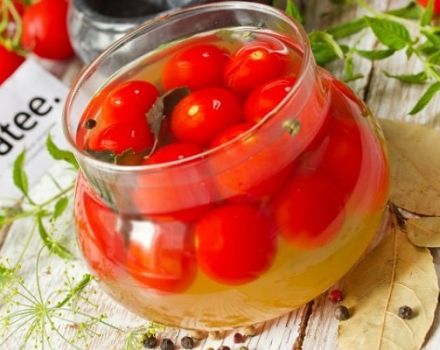Description and characteristics of Hungarian geese, pros and cons of the breed and care
Goose breeding is the most lucrative poultry industry. Birds grow quickly, carcasses have a significant weight. Before you start goslings in your own backyard, you should choose the right breed, because the profitability of the business, the amount of the required initial investment, depends on it. Detailed information about the Hungarian geese, their advantages and disadvantages, the distinctive features of this type of bird will allow you to make your choice.
Historical reference
The breed was bred by the efforts of Hungarian breeders in the 2nd half of the 20th century. It was officially recognized and got its name in 1969. Hungarian geese were obtained by crossing Pomeranian and Emdem geese with local breeds. As a result of the work, universal specimens appeared with high-quality taste indicators of liver and meat, excellent fluff and average egg production.
In 1989, Hungarian geese were brought to the Soviet Union. The breed is in the register of the Federal State Budgetary Institution "State Breeding Commission". They spread throughout the territory of the former USSR.
Characteristics and description of Hungarian geese
These are beautiful large birds with a muscular body and white plumage. Sometimes gray or colored individuals are found. The breed is suitable for farming and personal subsidiary plots. Distinctive features of the breed:
- refers to the heavy type of goose representatives, the goose is a giant weighing up to 7-8 kilograms, the goose is up to 6 kilograms;
- the body is powerful, muscular, proportional, with a broad back;
- beak and paws are colored bright orange;
- birds have a long flexible neck and a medium-sized head; females have a shorter neck than males;
- owners of short, strong legs and wings.
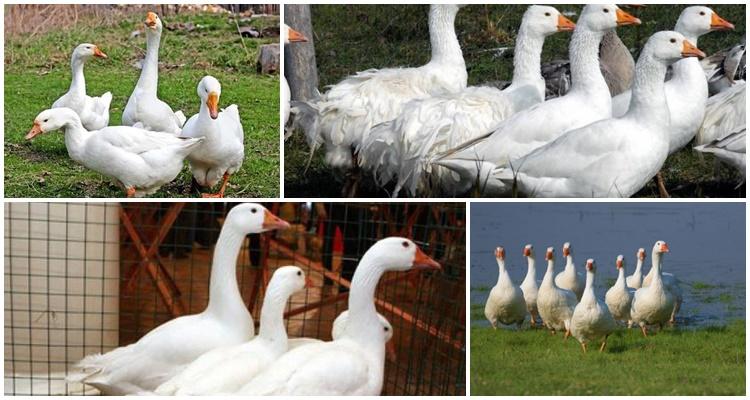
Geese of this breed have a lively, fighting character, high crowding of birds can cause clashes.
A balanced diet and comfortable living conditions ensure rapid growth of the livestock. The weight of the Hungarian liver reaches 0.5 kilograms, they get fluff 3-4 times a year. The meat is tasty and nutritious, goose fat is used in cosmetology, cooking, and folk medicine.
The main advantages and disadvantages of the breed
Geese are easy to care for, they are popular in rural backyards due to the following factors:
- birds quickly gain weight, carcasses are large, with high taste characteristics of meat;
- high-quality down and feathers provide the owner with additional income;
- geese of this breed are also kept for obtaining liver.
It is necessary to provide the birds with free range and access to the reservoir, this makes their maintenance cheaper and easier. The disadvantages of the breed include:
- the appearance of problems with high humidity in the goose house;
- geese lay an average number of eggs.
There are much more advantages than disadvantages, even with a small livestock, it is possible to provide a family table with quality products, with a significant number of birds, they provide a stable profit.
Conditions of maintenance and care
In the poultry house, geese are kept in the cold season, from April to October they spend the whole day walking, returning to the barn to spend the night. To make the birds comfortable, they provide good ventilation in the goose house, protect them from drafts, and provide additional lighting.
Geese are large birds, in order to prevent quarrels between them due to overcrowding, each individual should have 1 square meter of room area. The height of the house must be at least 2 meters, in order to save on electricity, windows should be made in it. The walls inside are plastered and whitewashed with slaked lime. This treatment protects them from mold and mildew.
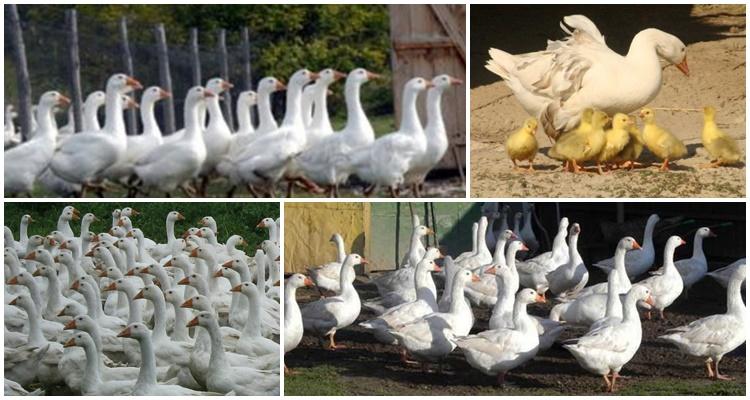
The room is divided into compartments using a grid. This is done in order to isolate the adult livestock from the young and create comfortable conditions for the geese incubating the chicks. The floor can be made of wood or earthen and covered with straw or sawdust. The litter in the goose house must be dry, the birds tolerate the cold, but suffer from high humidity in the room.
In addition to the shed, geese need a spacious walking area. For her, a flat area is selected, which is surrounded by a fence or covered with a net around the perimeter. The net is dug into the ground along the bottom so that the geese cannot get out of the pen. Drinking bowls, feeders, ash baths and a canopy are installed on the site so that geese can hide under it from the rain.
Drawing up a diet
Adult geese are able to digest roughage. They build up their mass on the waste of grain production, they are given wet mash of vegetables - pumpkin, sugar beet, potatoes.
Important: vegetables must be clean without any traces of rot and mold.
To increase the nutritional value, the birds are given a little compound feed. During the period of laying eggs, bone meal, chalk, crushed shells are introduced into the diet of geese. The birds are fed 3 times a day. In the morning, the geese are given 1/3 of the daily norm of grain and compound feed. For lunch, birds receive raw or boiled vegetables, hay and also 1/3 of compound feed and grain. Evening feeding - the remaining third of the compound feed, silage, oats.
In summer, the birds are given compound feed and grain 2 times a day, in the morning and in the evening. During the day, geese find green grass on their own or bring it to the pasture at the rate of 2 kilograms of green mass for each adult bird.
Breeding rules
Geese begin to lay after 9 months of age. Individual nests or houses for 2-3 individuals are equipped for them. Hungarian geese are great mothers. The eggs hatch for 28-30 days. For the appearance of goslings, you can also use an incubator or buy already hatched chicks. After their appearance, they are divided into 2 groups, the weaker ones are separated from the strong individuals.
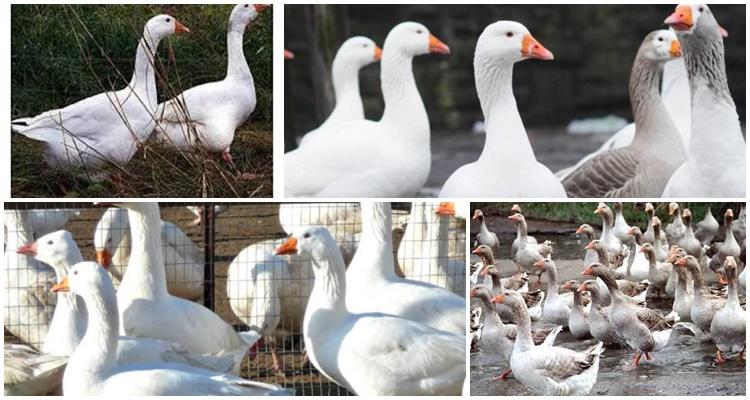
The hatched babies are kept under a lamp. In the early days they are given a mash of eggs, boiled crushed oats.After the first week, cottage cheese is included in the diet, small nettle brooms are hung in the room, so that the goslings can reach them. They need fresh water. Babies are allowed out on the street from 3 weeks, if the temperature rises to +20 ° C.
Diseases and their treatment
An adult goose is given anthelmintic drugs and tick medications. For treatment use "Alben" in accordance with the instructions, or other drugs. Dangerous viral enteritis, salmonellosis, which often affect goslings. Diseases are treated with antibiotics as prescribed by a veterinarian.
Aspergillosis is a fungal infection, therefore, for treatment, they use antimycotinic drugs or fumigate the room with iodine monochloride. Rickets occurs when a poultry has a deficiency of vitamins and microelements. In the poultry house, they put chalk, crushed shells, give the birds bone meal. Cannibalism occurs with high humidity and crowded birds in a room. They begin to clean the feathers, pulling them out and leaving wounds on the body.
Most of the problems are eliminated by putting things in order in the goose house. Cleaning and ventilating, replacing the litter and removing moisture - these simple measures are the prevention of disease. Good bird care, quality nutrition and responsibility allow you to raise geese in a complete lack of experience. Most of the farmers started with a dozen goslings, and then the occupation fascinates and begins to make a profit.

